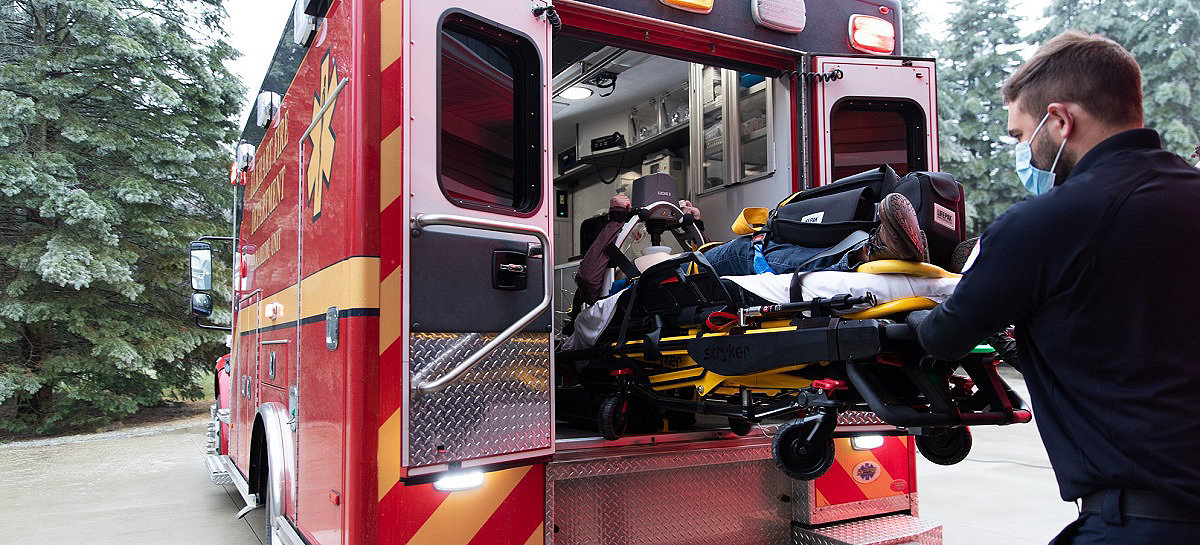26-Apr-2023
3-minute read
Being an EMT is a demanding job, both physically and emotionally. The repetition of loading and unloading cots in and out of an ambulance day after day can take its toll on the body.
EMS workers experience musculoskeletal injuries from overexertion five times more often than the average U.S. worker.1 Studies show manual patient handling is the single greatest risk factor for overexertion injuries for healthcare workers.1
A costly problem
At any given time, 10 percent of the EMS workforce is out of work due to EMT injury.2 In fact, one in four caregivers suffer a career-ending back injury within the first four years of employment3 and low back strain causes 78 percent of compensation days in the U.S. alone.4
Incredibly, the cost of a typical strain injury is $67,248 ($32,023 direct and $35,225 indirect costs).5 With these grim statistics, what can be done to recruit and retain EMTs and paramedics in your community?
Six tips for success
In 2017, the Center for Disease Control and Prevention (CDC) and National Institute for Occupational Safety and Health (NIOSH) published six recommendations for reducing risk in EMS:6
1. Protect workers and promote safety, health and well-being through workplace policies, programs and activities
2. Promote safe patient-handling techniques
3. Protect workers from exposures to blood and other potentially infectious body fluids
4. Prevent slips, trips and falls
5. Improve motor vehicle safety
6. Prevent violence by patients
Unfortunately, many of the recommended risk-mitigation steps outlined above are overlooked, causing unnecessary injuries, loss of staff and high workers' compensation costs.6

Better equipment matters
While Stryker's been developing innovative products for more than 80 years, nobody knows what works in the field better than EMS caregivers. That's why we reimagined our proven powered ambulance cot design to redefine the EMT's partner on scene—focusing on what matters most to help them get the job done.
Our response inspired Power-PRO 2 powered ambulance cot—the industry's first connected powered ambulance cot—performs a true, unassisted lift with smarter hydraulic assembly and load-sensing capabilities, effectively raising and lowering a cot and patient up to 700* pounds with just the touch of a button—reducing spinal loading, lost or modified workdays7 and helping increase recruitment and retention. The Power-PRO 2 also reduces the chance of cot damage and medic or patient injury with new bumper detection technology.
The Power-LOAD powered cot fastener system is a safe, durable and easy-to-use solution that could help reduce the risk of debilitating back injuries for EMS caregivers. Power-LOAD improves guided loading and unloading of patients, with a safe working load of up to 700 pounds, eliminating the need to lift the cot into and out of the ambulance. The Power-LOAD inductively charges your Power-PRO 2 or Power-PRO XT powered ambulance cot battery when in the transport position —helping keep your powered cots charged and ready to use.
Both the Power-PRO 2 powered ambulance cot and Power-LOAD powered cot fastener meet dynamic crash test standards†—helping attract and retain EMTs and paramedics by reducing the likelihood of job-related injuries.
Proven to save guarantee8,9
At Stryker, we stand behind our products. For qualifying purchasers8, upon standardization, Stryker offers a program that guarantees at least a 50 percent reduction in cot-related injuries pertaining to raising, lowering, loading and unloading cots and 100 percent reduction in missed safety hooks while unloading cots with the Power-PRO and Power-LOAD in full power operation. If not, Stryker will refund the price paid for the Power-PRO cots and Power-LOAD cost fastening systems.9
Saving lives shouldn’t be back breaking
A 100 percent reduction in cot related injuries saved one organization $545,500 over four and a half years,10 and 99 percent of those surveyed agree that Stryker’s Powered System makes their jobs easier.11
“The Powered System has extended the careers of our paramedics, protected patients
and reduced on the job injuries costs by hundreds of thousands of dollars,”
- Shane Cohea, Director of Safety and Security for Norman Regional Health System
Together, we save lives
Connect with a Stryker representative to learn more about the Powered System.
*Maximum unassisted lift capacity is 500 pounds. Cot loads over 300 pounds may require additional assistance to meet set cot load height.
1. https://www.cdc.gov/niosh/topics/safepatient/default.html.
2. Studnek JR, Ferketich A, Crawford JM. On the job illness and injury resulting in lost work time among a national cohort of emergency medical services professionals. Am J Ind Med, 2007 Dec; 50(12):921–31.
3. Sanders, Mick J. (2011) Mosby’s Paramedic Textbook (4th ed. P. 36).
4. https://www.sciencedirect.com/science/article/pii/073567579090081A.
5. https://www.osha.gov/dcsp/smallbusiness/safetypays/estimator.html. As of August 1, 2018 with a 3% profit margin for strain.
6. https://www.cdc.gov/niosh/docs/2017-194/pdfs/2017-194.pdf.
7. Fredericks T, Butt S, Harms K, et al. Evaluation of medical cot design considering the biomechanical impact on emergency response personnel. The XXVth Annual Occupational Ergonomics and Safety Conference. 2013.
8. Contact your sales representative to see if you qualify for the EMS guarantee.
9. Subject to the terms and conditions of EMS Proven to Save.
10. Stryker (2018). EMSStat – Norman Regional Health System Case Study (Case Study on Power-PRO XT cots and Power-LOAD cot fastening systems). Retrieved from: http://ems.stryker.com.
11. Stryker (2016). Staff Satisfaction Case Study (Case Study on Power-PRO XT cots and Power-LOAD cot fastening systems). Retrieved from: http://ems.stryker.com.
Stryker Corporation or affiliated entities own, use or have applied for the trademarks or service marks, Power-LOAD, Power-PRO, Stryker. All other trademarks are trademarks of their respective owners or holders. The absence of a product or service name or logo from this list does not constitute a waiver of Stryker's trademark or other intellectual property rights concerning that name or logo.
Copyright © 2021 Stryker. Do not copy, reproduce, distribute, publish, modify, create derivative works, transmit, or exploit the copyrighted materials without prior permission from Stryker.
Mkt Lit-2107 27 OCT 2020 REV B

